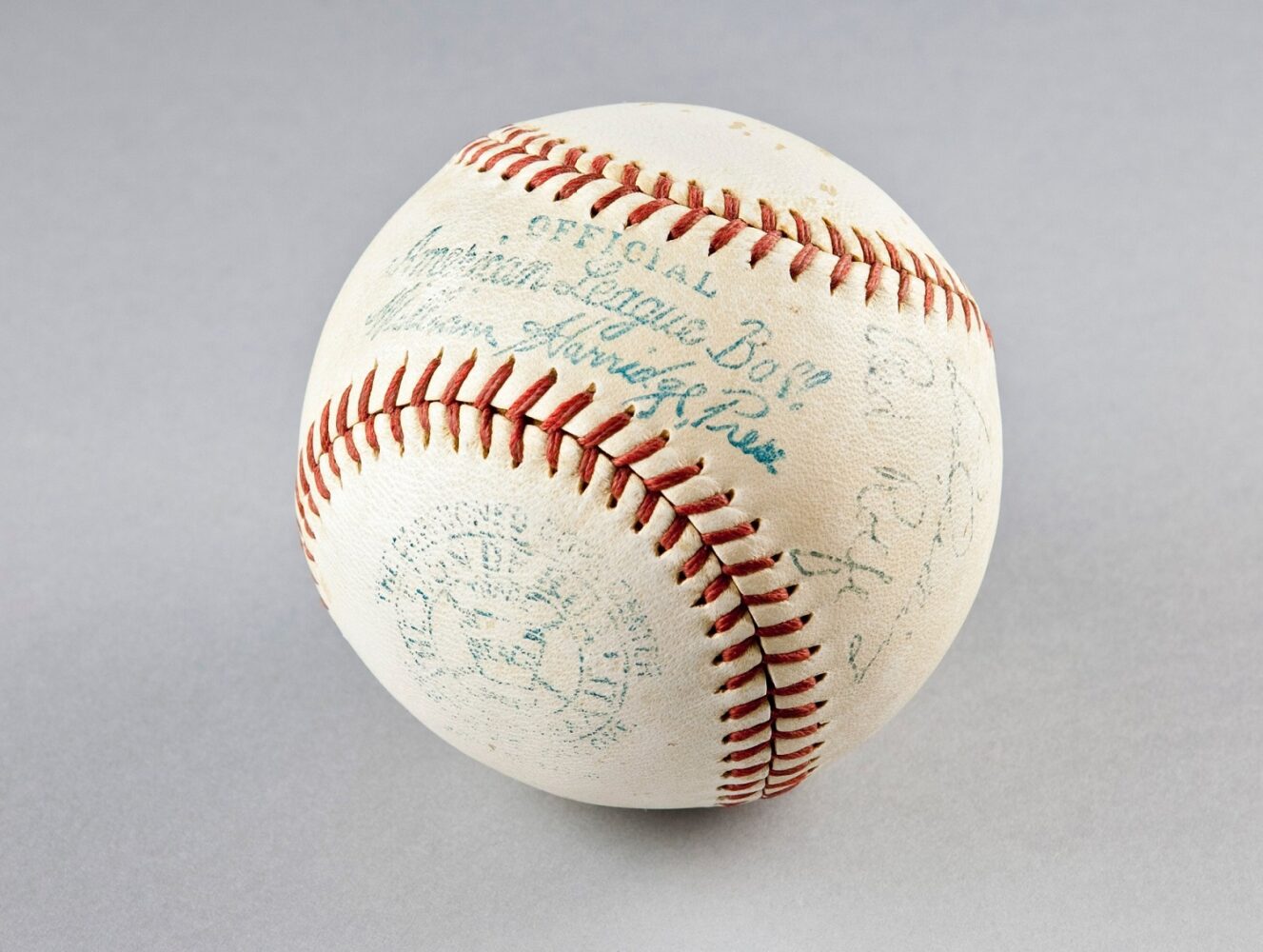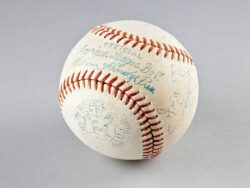The Boot on the Diamond
Football-mad Louisiana does well at baseball, too
Published: August 31, 2021
Last Updated: March 22, 2023

Photo by Mark J. Sindler, Louisiana State Museum
Baseball signed by Mel Ott and other players, on display at the Louisiana Sports Hall of Fame.
But the national pastime has held a special place in the hearts of Louisiana sports fans for almost a century. In fact, Louisiana’s connection to the sport links it with baseball’s most storied franchise, the New York Yankees, who held their spring training camp in New Orleans for three successive years beginning in 1922. Several other major league teams trained in New Orleans, Baton Rouge, and Shreveport throughout the 1920s and into the 1930s. Major League teams also barnstormed throughout Louisiana in the off-season, playing local teams and intrasquad games.
Louisianans are familiar with the sprawling Capitol Complex in downtown Baton Rouge. Anchored by the thirty-four-story Capitol, it includes the Capitol Annex, the Louisiana State Museum, the Arsenal Museum, the State Library, and the Pentagon Barracks. Not so well-known is the fact that the LSU campus occupied this area from 1896 until its move to the present campus in 1925. Just north of the Pentagon, now occupied by the Annex and the Claiborne Building, were the school’s athletic fields. It was there that the Yankees, led by Babe Ruth, played an exhibition game in 1921. The Yankee connection continued some fifty years later when the team’s owner, George Steinbrenner, befriended Coach Eddie Robinson of Grambling State University and became the benefactor of the Whitney M. Young Jr. Urban League Classic, which annually featured the Grambling Tigers playing another historically Black college football team to fund scholarships for needy Black students from New York City. The game was often played in Yankee Stadium. In the late 1980s, Steinbrenner brought the Yankees to the Grambling campus to play three baseball exhibition games against the Tigers.
Minor League Baseball has been a part of the Louisiana sports landscape for decades as well. The Alexandria Aces were the preeminent team, having been part of the popular Evangeline League throughout its twenty-one-year existence from 1934 to 1957 (skipping the WWII years). The New Orleans Pelicans were a part of the Southern Association from 1901 to 1959, folding two years before the league disbanded. More recently, multiple Louisiana cities have welcomed farm teams in Class A and Class AA. The New Orleans Baby Cakes (formerly the Zephyrs) were the state’s lone AAA affiliate.
The Baton Rouge Kids’ Baseball Clinic for more than fifty years was the nation’s premier free clinic. In its heyday in the 1960s, superstars regularly came to town in February for a pre-spring training clinic that drew thousands of children to several locations in Baton Rouge for free instruction from big leaguers and minor league prospects. Luminaries who attended included Ted Williams, Stan Musial, Lefty Gomez, and Dizzy Dean, to name but a few.

Young baseballers in training, New Orleans, ca. 1900. Photo by George François Mugnier, courtesy Louisiana State Museum
Against this backdrop it’s easy to consider an imaginary all-time all-star team of native Louisianans. It’s a roster that could compete with a similarly created team from any other state in the Union.
Here’s the lineup, which appropriately starts with a pair of Yankees:
Catcher
Bill Dickey, a Bastrop native, whose nineteen-year career led him to induction in the Baseball Hall of Fame. He was an eleven-time All Star and seven-time World Series champion who batted .303 for his career that ended with Dickey as manager of the Yankees in 1946.
Starting Left-Handed Pitchers
Ron Guidry of Lafayette was nicknamed “Louisiana Lightning.” He spent an illustrious fourteen-year career with the Yankees. He won the Cy Young Award and the Roberto Clemente Award, and was a member of two world championship teams. He won five Gold Glove Awards. His jersey number, 49, was retired by the Yankees.
Vida Blue, from Mansfield, won the Cy Young and Most Valuable Player Awards in 1971 and led the Oakland Athletics to three consecutive World Series championships.
Starting Right-Handed Pitchers
Ted Lyons went from Lake Charles to the Baseball Hall of Fame following a twenty-year career from the 1920s to the 1940s. An All-Star in 1939, he threw a no-hitter in 1926 and led the American League in wins in both years before and after his gem. His entire career was with the Chicago White Sox, having never played a minor league game. After his playing career, he managed the Sox from 1946 to 1948.
Ben McDonald, a Denham Springs native and LSU Tiger, won the Golden Spikes Award as the nation’s Most Outstanding Player in 1989. He was the top pick in the Major League draft and led the US team to a gold medal in the 1988 Olympics.
Reliever
Lee Smith, born in Jamestown and raised in Castor in Bienville Parish, retired from major league baseball in 1997 as the record holder for career saves (478). In his eighteen-year career he was a seven-time All-Star and three-time winner of the Rolaids Relief Man Award. He is a member of the Baseball Hall of Fame.
First Base
Will “The Thrill” Clark of New Orleans played college ball at Mississippi State where he won the Golden Spikes Award. He spent fifteen seasons in the majors, playing in six All-Star games and winning two Silver Slugger Awards and a Gold Glove Award. He is a member of the College Baseball Hall of Fame.
Second Base
Todd Walker, who spent his high school days in Shreveport, was the Most Outstanding Player in the 1993 College World Series, leading the LSU Tigers to their second national championship. He played with seven teams during his twelve-year major league career and was inducted into the College Baseball Hall of Fame.
Shortstop
Alvin Dark was born in Oklahoma but raised in Louisiana. He was a two-sport star at LSU and the Major League Rookie of the Year in 1948 with the Boston Braves. He had more than two thousand hits in his career with six teams, making three All-Star teams. Thereafter, he managed five big-league teams.
Third Base
Rickie Weeks Jr., a natural second baseman, made the team at third base based on his career at Southern University, where he won the Golden Spikes Award in 2003.
Outfielders
Lou Brock moved to Collinston in Morehouse Parish when he was two years old. He broke into the major leagues with the Chicago Cubs but spent most of his nineteen-year career with the St. Louis Cardinals, finishing with more than three thousand hits. He was a six-time All-Star and broke Ty Cobb’s career stolen base record in 1977. He is a member of the Baseball Hall of Fame.
Mel Ott, a Gretna native, played right field from 1926 to 1947 for the New York Giants, a team he subsequently managed for eight years. Clearly the most prominent of all Louisiana baseball players, he led the National League in home runs six times, finishing with 511 dingers for his career. He was an All-Star eleven times and led the Giants to a World Series championship in 1933. He is a member of the Baseball Hall of Fame.
Albert Belle, from Shreveport, known as Joey during his days at LSU, had a memorable 1995 season with the Cleveland Indians. He led the American League in home runs, runs batted in (RBIs), slugging, and total bases, finishing second in hitting. He became the first player to hit fifty home runs and fifty doubles in the same season. He was a five-time All-Star.
Designated Hitter
Willard “Home Run” Brown of Shreveport played for the Monroe Monarchs and the Kansas City Monarchs of the Negro League and spent a brief time with the St. Louis Browns in 1947. He was the first African American to hit a home run in the American League. He won two triple crowns in the Puerto Rico Winter League and was given his nickname by fellow Baseball Hall of Famer and Negro League superstar Josh Gibson.
Pinch Hitter
Warren Morris, of Alexandria, hit a dramatic two-out bottom-of-the-ninth walk-off home run, giving LSU the College World Series championship in 1996.
Manager
Although several on this mythical team had successful managerial careers, the All-Louisiana team manager is Ron Washington of New Orleans, who managed the Texas Rangers from 2007 to 2014, leading the team to two consecutive World Series. He could be joined in the dugout by LSU legends Skip Bertman and Paul Manieri, Southern’s Roger Cador, Grambling’s Wilbert Ellis (all members of the American Baseball Coaches Hall of Fame), and two 2021 inductees in Rick Jones (Tulane) and Tony Robichaux (University of Louisiana at Lafayette).
No discussion of baseball in Louisiana would be complete without mentioning legendary scout and executive Mel Didier, whose family has a multi-generational link to both collegiate and professional athletes in Louisiana.
Yes, we love our football in Louisiana. But the baseball firmament has been brightened by this impressive list of Louisianans: Six Baseball Hall of Famers, three Golden Spikes winners, a hard-throwing pitching rotation, and a powerful batting order spanning almost a century of baseball.
Jay Dardenne, the 53rd lieutenant governor of Louisiana, is a baseball fan.
